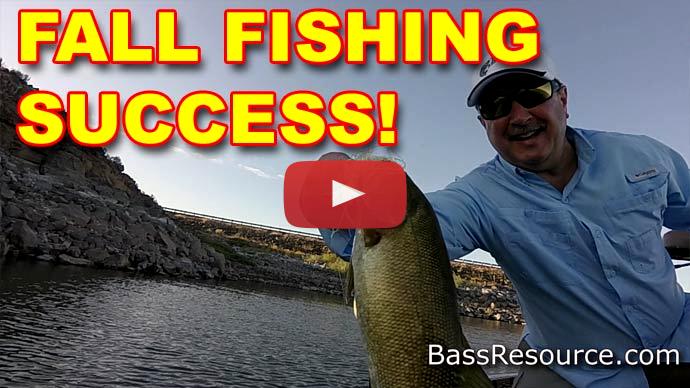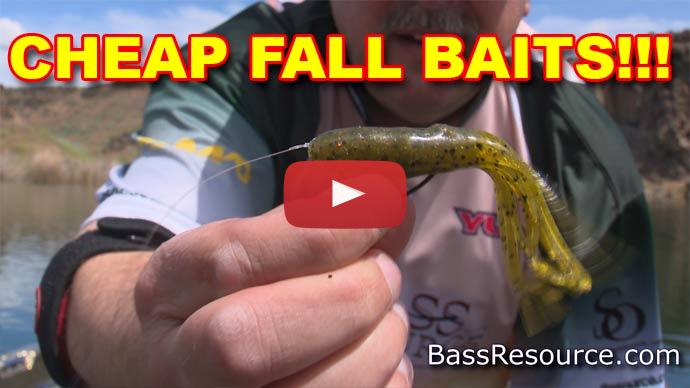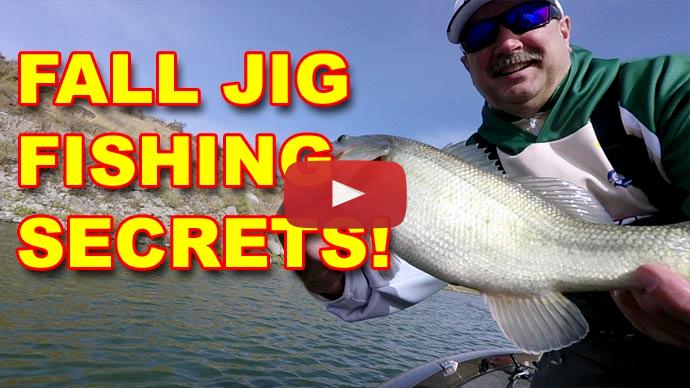Keri: There we go!
Glenn: Nice! Alright. Get ‘em Keri! Get ‘em.
Keri: There’s one particular spot out there. And you have to be spot on it to do it. One spot
Glenn: That’s how you use deeper jigs for fishing. That’s a good healthy fish.
Keri: That’s a healthy fish. Oh yeah, I had him that time. You weren’t going nowhere. Look at that
Glenn: Nicely done.
Keri: Jig fishing. Woo hoo! One more and mama get’s a beer! (laughter)
Glenn: Hey, folks. Glenn May here at BassResource.com. Today, I wanna talk about catching bass during the late fall. Like, what's the approach to that and what are the main lures to use. So, what I'm gonna talk about is the top considerations that you need to think about during this part of the season, and then how do those lures and presentations tie into that? So, let's get into that.
First of all, in the fall, in the late fall, there's four key considerations you need to think about. It's water temperature, depth, it's fronts, you know, weather fronts, and lure color. So, first one is temperature.
The thing about the fall and especially in late fall is you rise and shine in the morning and gosh, it's cold out. You know, this morning, it was 46 degrees out. So, it was cold. Now, it's almost 70. It's nice, but you get out there and you're bundled up and you feel like it's winter almost. You can see your breath. There's a good chill in the air and you might think, "Okay, these fish are lethargic. They're not moving around much. They're probably gonna be deep. I got to fish with them deep." Pay attention to your temperature gauge because a lot of times, the water temperature is still up in the 60s. Maybe even the low 70s and the fish are going by that. That's their reality. And if the water temperature is that warm, they're gonna be up shell right away in the morning, even though your cold may mean the fog is out and you're like chills, but you're catching them on topwater. So, believe that temperature gauge. It's real important because you might miss a lot of fish if you're fishing by the way you feel the air temperature is.
So, that's rule number one. Number two is depth. In the early fall, you know, the fish move up shallow. They're going crazy. Getting a bunch of baitfish and they're eating heavily. But what happens mid and into the later part of the fall, the days get shorter, the air cools down, the water temperature cools down, those weeds start to die off in the shallows. And when they're dying, they're consuming oxygen rather than creating it. And so, that's gonna push all those baitfish and the bass out deeper water to greener weeds.
So, the first thing you wanna do in this is part of the season is to find the green weeds. If your lure is dragging up brown or dead weeds, get out of there, go deeper until you start dragging up green weeds because that's where the fish are gonna be. So that depth is real important.
Also, keep in mind that weather systems are gonna affect it. And this is where I get into the, you know, the fronts. This has to do, kind of, positions them as far as depth to, kind of, intertwine here.
Early in the fall, the first fronts that come through aren't very strong, they usually don't have much of an effect on the bass at all, but as fall progresses, the fronts gets stronger and stronger and they have a greater impact on them. The water temperature drops to a greater degree. The barometric pressure drops more. And so a lot of times what happens is the fish will be upon those green weeds, actively chasing fish, front comes through. And what happens, especially like shad will do this, they'll move out of the weeds and if there's a nearby creek channel, they'll get right down in the middle of that creek channel. They'll hunker down in the deepest part of that creek channel. They're not gonna move all the way out to the main Lake, but the deepest area nearby is where they're gonna go. And that maybe only 20, 30 yards from that weed bed. So, don't go running off, chasing them somewhere else, but it's gonna determine their depth and the strength of that front is gonna determine their disposition.
If it's a real strong front, those fish may almost get locked jaw. They may be unwilling to chase down fast-moving baits, and you have to go to real slow-moving bait to go after him. We'll get to what bait is use in a second, but something to keep in mind, if you've had a long stretch three or four days or more without any fronts coming through, and those fish will move back up and those weeds again, and there'll be shallow and actively chasing fish.
So, the progression from shallow to deep water is not linear. They're gonna be shadowed one day, deep the next, deep a few more days, and they're gonna be shallow again for a few days, then they're gonna be deeper. The trend over time will be a general transition to deeper water, but keep in mind with the depths are where the green weeds are and with these fronts coming through and the water temperature combined, those fluctuations is gonna determine where those fish are during this late part of the season.
Now, to me, this is...you know, the fall is one of the more important times of the year to pay attention to lure color. Earlier in the season, the fish are up, they're shallow chasing shad or they're chasing a lot of perch. If you don't have shad and you're like...or sculpin or what have you. But as time progresses, what I've noticed is that the shad become less and less an important product of their diet. And it's not eliminated. They still feed on the shad, but what becomes more, you know, folded into their diet is bluegill. And because of that reason, chartreuse becomes an important color to have. I usually have a splash of chartreuse on whatever lure I'm using, especially in late fall. Whether it's a spinnerbait, a jig, or especially a crankbait.
Firetiger crankbaits during the fall are like candy. It's crazy. I'll throw up a firetire or a crankbait in the spring or in the summer and not do very well, but in the mid to late fall, hang on. Those fish will slap the paint out of it, man. They'll hit it so hard. It is because of that transition going after those more perch and going after the bluegill, I believe it's that firetiger, why it's so popular during this time of the year and why it works so well. So chartreuse color is real important during this time of the year.
There’s another one.
Keri: Awesome!
Glenn: This is ridiculous fishing.
Keri: But we like it.
Glenn: These fish love this finesse jig.
Keri: Well they’re trying to get fat for the winter. It’s like “crawdads!”, “crawdads!”
Glenn: This is another good one. Look at this. Another nice keeper here.
Keri: They’re all about the same size, aren’t they?
Glenn: Ya. I swear I’m not catching the same fish over and over again.
Keri: Sure does look like though doesn’t it?
Glenn: Good old finesse jig.
Now, let's get a little more into the baits and a little bit more going after these fish. Like I said before, they're up shallow. Now, we're mid-fall, we're getting into late fall. So, these fish are gonna go where the green patches of weeds are. So, there's a couple of ways to attack those weeds.
One of them is with a crankbait. Like I mentioned, a deep-diving crankbait is what you're gonna need. And the problem with going fishing weeds with the deep-diving crankbait is that you can get hung up in the weeds. So, you wanna get out to the outside edge of those weeds, the deeper part of those weeds, but you don't wanna get so far away that you're away from the strike zone. You wanna get those bass that are, kind of, cruising along the edge of those weeds. So, the sweet spot is where you're occasionally picking up a couple of strands of weeds here and there while you're cranking it, while not dredging up a whole bunch of weeds. So, you have to position yourself to finally get to that sweet spot, but that's where you want to bring that crankbait right down in there, give it frequent pauses and little twitches, speed it up, slow it down, change cadence, and you're gonna catch a lot of fish that way.
Now, what I've also found is if you got patches of weeds instead of a big flat, big expansive weeds, if you've got patches of weeds, I find that a lipless crankbait works better there because then, I can bring it over the top of it. I can actually get hung up in those weeds a little bit, give it a hard yank, rip it out of those weeds it’ll rip the weeds off of them, and that sudden motion, that burst of energy often triggers a strike. So, I do that. I attack them that way, plus I also attack those patches with spinnerbaits. I get a half ounce, sometimes three-quarter round spinnerbait depending on how deep those weed patches are and I'll bring it right along the sides or right over the top of those patches, and I'll just not necessarily slow-roll it, but bringing a slow enough pace where it goes along the bottom, horizontally to the bottom. So you're not bringing it up. So, you may have to slow down, a little bit slower and slower as it gets closer to you to maintain that trajectory and play around with that speed. Play around with that cadence to figure out what the fish want that day, but a spinnerbait can be very, very effective.
Another lure that I use to go after these weeds and also, you know, say they're on a hump and they're sitting on top of the hump and when there's weed beds on top of the hump, or rocks, or some logs, maybe it's a primary or secondary point, great bait to use as a jig. I'll use a 3/8 ounce jig and cast it along those weed edges. As I said, weeds are key. So, that's where I'm gonna go after first with a jig. Just let it fall vertically right down. A nice slow fall is what you want. So, 3/8 ounce jig. You know, it's deeper water. I'll stick with that 3/8 ounce, unless it's windy. The wind is picking up. It's a little more difficult to maintain contact with that bait. And so, I'll use a half-ounce maybe and three-quarter ounce, but a slow fall is really what you want because it looks like a baitfish or something is dying.
There we go.
Keri: Yeehaw! You got a fish. You have a smallie or a largie?
Glenn: We got a largemouth.
Keri: You got a largemouth. A nice largemouth too. Nice fatty.
Glenn: Look at that.
Keri: Look at the color.
Glenn: Boy he’s cold!
Keri: I bet he is cold
Glenn: Cold water jig fishing
Now, if these fish have pulled off, that fronts come through and as they pull off into that creek channel, or maybe they're on top of the humps and now they're off to the sides, or on the bottom, or they pull off a little bit deeper off those points where there aren't weeds, then I’ll break out a football head jig. And I wanna get down to the bottom and just crawling, really slow. Football head jig as you crawl on the bottom, it wobbles like this, and it looks like a little crawdad, the whole body of it, the claws sticking up and everything like this, and just wobbles on the bottom. Real slow with long pauses in between. Usually, that gets a bite.
However, I've noticed sometimes that the fish will pick it up and spit it out right away, or they don't bite it very long, or they don't hold on to it very well and you don't get a good hookset. When that happens, that's when I break out my secret bait and that's a tube.
A tube jig works very, very well this time of year. It resembles both the baitfish and a crawdad. It collapses when the fish bites it. So, they hold onto it longer, plus you can put scent in it, which allows them to hold on even longer. So, the fish are nipping at those jigs and you not getting hook sets on them. That's a good indication you should flip to a tube jig. Usually at three and a half-inch or four-inch tube works really, really well because an open head jig with the eye, it's a 90-degree eye, a little bit offset from the front so that when you drop it on slackline, it just gives this nice death spiral. It looks just like a dying baitfish. Perfect for the fall. That works really, really well. I've been using like an eight-ounce weight, real lightweight. And I will do that as long as I'm not getting hung up on anything. That is the primary way that I'll fish it.
But if those fish wants something on the bottom and barely moving, then I'll use a jig that's, you know, it's a Texas rig, so it doesn't get hung up and I'll put it, like, behind a split shot or on a drop shot rig and get it down there nice and deep. Texas rig it so it doesn't get hung up on anything and I'll move it real, real slow. Just dragging on the bottom. Just don't even let it pop up the bottom. Those fish are real reluctant to bite. That often gets the best bite of all when they're very, very finicky, something bite a tube they can't resist. And so, you can still salvage the day and catch some fish, even when the bite is slow in the late fall.
So those are the main baits I use. That's the tactics and approach I use in the late fall. I hope that works for you. For more tips and tricks like this, visit BassResource.com.



